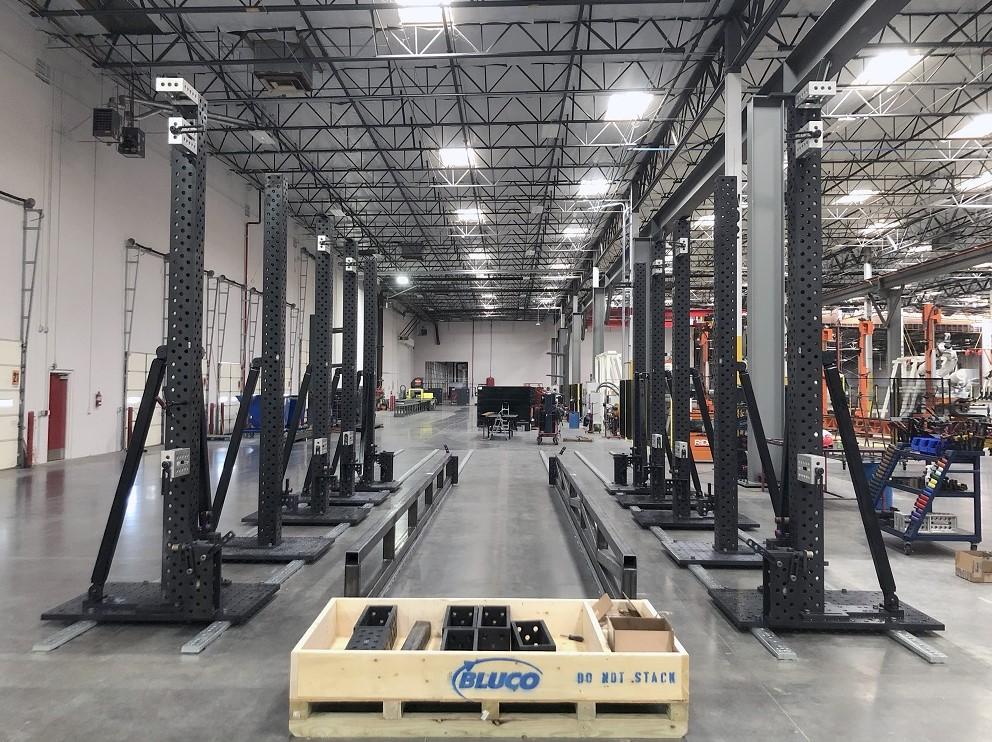- FMA
- The Fabricator
- FABTECH
- Canadian Metalworking
Categories
- Additive Manufacturing
- Aluminum Welding
- Arc Welding
- Assembly and Joining
- Automation and Robotics
- Bending and Forming
- Consumables
- Cutting and Weld Prep
- Electric Vehicles
- En Español
- Finishing
- Hydroforming
- Laser Cutting
- Laser Welding
- Machining
- Manufacturing Software
- Materials Handling
- Metals/Materials
- Oxyfuel Cutting
- Plasma Cutting
- Power Tools
- Punching and Other Holemaking
- Roll Forming
- Safety
- Sawing
- Shearing
- Shop Management
- Testing and Measuring
- Tube and Pipe Fabrication
- Tube and Pipe Production
- Waterjet Cutting
Industry Directory
Webcasts
Podcasts
FAB 40
Advertise
Subscribe
Account Login
Search
Modular building manufacturer looks to modular fixturing to double production
- May 26, 2021
- News Release
- Assembly and Joining
Situation
When Zekelman Industries announced the launch of its Z Modular facility in Arizona in 2019, the company had a goal to build steel-framed, volumetric, modular building units to 1/16-in. tolerance and deliver them fast, without cost overruns. And the firm had most of the ingredients it needed to reach that goal.
The Arizona facility—Z Mod’s third—would be producing 90% of the raw materials needed for construction, including the steel (Zekelman’s specialty), so timelines were mostly under the company’s control. And it had a knowledgeable team in place.
The plan was eventually to rely on automation to deliver the speed required to take the company over the top. But Matt Miller, Z Mod’s Chandler plant manager, wanted to establish that speed even before the automation came online. “Not only that,” said Miller, “but there were also the usual factors that are just a part of modular construction, including the need to fixture for an infinite number of size variations.”
Miller realized a modular fixturing system made sense for Z Modular’s high-mix/low-volume production. “I knew we needed a modular system, because we build so many different assemblies with different dimensions,” he explained. “We needed something that was flexible so we could move the tooling around quickly and easily.”
Resolution
Miller reached out to Bluco Senior Application Engineer Todd Bennett, who told Miller something he was hoping to hear: Bluco had done this before. The company had fixtured not only Z Mod’s Texas plant, but another modular construction facility located near Bluco in Naperville, Ill. Miller visited Bluco’s on-site Validation Center and the modular construction facility nearby, where he was able to see similar systems in action.
With a taste of what could be accomplished using modular fixturing, Miller started assembling a wish list. While he originally wanted one fixture for roof assemblies and another for floor assemblies, “he asked us if we could design a single fixture that would hold both assemblies at the same time,” Bennett said.
The result was a 60-ft.-long floor rail system with 13-1/2-ft. vertical modular U-forms. From design to installation, the system was up and running in 45 days.
“We weren’t just designing for what’s happening there this week, or even this year,” Bennett explained. “We looked ahead to design for what happens when the automation comes online. Looking past that, how could we make it repeatable in other facilities?”
Miller now can do two assemblies in the time it would have taken to do one under the original plan. “Even when the automation comes online, we’ll still be using the Bluco system,” he said. “It will just help us build that many more.” On top of that, he’s saving space. “If we had gone with a fixed positioning system, we’d be really limited in our ability to move tooling around, and it would have taken up a lot more floor space.”
Another goal of this project was to leave the team at Z Mod in a position to be able to handle additional fixture designs themselves. To that end, Bluco provided training on how to manipulate the modular components in CAD.
Related Companies
subscribe now

The Fabricator is North America's leading magazine for the metal forming and fabricating industry. The magazine delivers the news, technical articles, and case histories that enable fabricators to do their jobs more efficiently. The Fabricator has served the industry since 1970.
start your free subscription- Stay connected from anywhere

Easily access valuable industry resources now with full access to the digital edition of The Fabricator.

Easily access valuable industry resources now with full access to the digital edition of The Welder.

Easily access valuable industry resources now with full access to the digital edition of The Tube and Pipe Journal.
- Podcasting
- Podcast:
- The Fabricator Podcast
- Published:
- 04/16/2024
- Running Time:
- 63:29
In this episode of The Fabricator Podcast, Caleb Chamberlain, co-founder and CEO of OSH Cut, discusses his company’s...
- Industry Events
16th Annual Safety Conference
- April 30 - May 1, 2024
- Elgin,
Pipe and Tube Conference
- May 21 - 22, 2024
- Omaha, NE
World-Class Roll Forming Workshop
- June 5 - 6, 2024
- Louisville, KY
Advanced Laser Application Workshop
- June 25 - 27, 2024
- Novi, MI































